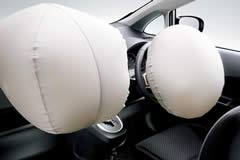How Airbags Work And How Can I Check If They Will Work Fine? - Vol.211
Did you know that the first time airbags were ever sold together with a vehicle was in 1973 in the Oldsmobile Toronado? In fact, the first federal law that required safety bags be installed into vehicles didn't come around until 1998. Research shows that the standardization of airbags can increase your chance of survival in a head-on collision by 30%. But how exactly do these life saving devices work and when was the last time that you checked to make sure yours work when they are supposed to?

An Airbags Core Purpose Is To Reduce Your Speed
In order to understand how an airbag works, you need to understand what exactly an airbag does. If you were driving down the road at 45 miles per hour and someone runs head first into you, your car would come to an abrupt stop, releasing energy that would result in an impact damage to your vehicle; however, your body would continue moving forward at the current momentum?45 miles per hour?until an outside force was able to slow you down.
Without airbags, or a seatbelt for that matter, that outside force could be the dashboard of your car or the windshield. If any part of your body smashes into either one of these two objects at 45 miles per hour, you risk serious injuries or death. A seatbelt helps to restrain your body with the structure of the vehicle, and an airbag inflates to offer resistant and bring your body to a resting state and eliminate forward movement.
The Inner Workings Of An Airbag
Inside the steering column and passenger side airbag compartment, there is a thin nylon bag folded tight. Accompanying the airbag is a sensor that is set to detect sudden bursts of force equivalent to 10-16 miles per hour. Once impact is detected, a combination of sodium azide (NaN3) and potassium nitrate (KNO3) are released into the nylon bag, causing a chemical reaction that produces nitrogen gas (N2).
Nitrogen gas released within the nylon airbag will cause the airbag to rapidly inflate and burst through the container containing the bag. Federal laws require that this entire process occur at minimum speeds of 30 miles per hour, but some models have been tested at up to 200 miles per hour.
There are vents within the bag itself that permit the nitrogen gas to release. The reason that the bag is able to expand in the first place without all the gas escaping is because the initial pressure being exerted by the airbag is greater than that of the surrounding atmosphere. Once it neutralizes after the initial reaction and reaches pressure of the surrounding environment, the bag will naturally deflate allowing the occupant to move around.
How To Test Your Airbags
Should the unfortunate event happen and you ever do get into an accident, you want to make sure that your car's airbags are fully functional. When you go to start your vehicle, you should see a picture on the dashboard of a an seated figure and an inflated airbag, or 'SRL.' If your airbags are in solid working condition, the light should go off during the first few seconds after starting the vehicle. When that same light remains or starts to flash, that means that there is a problem with your airbag system.
The flashing is actually an indicator code of the problem that your car is experiencing. The first few flashes before the pause indicate either 10's, 20's, 30's, etc. The second few flashes after the pause indicate 1, 2, 3, and so on. For instance, if the light flashes twice, pauses, then flashes three more times, the problem code is 23. Use this number to research and remedy the problem.
Cars without these electronic signals will require manual electrical testing. It's best to take your car into a trusted mechanic to manually test the airbags, especially if you don't have much electrical experience or tools necessary to perform the test.